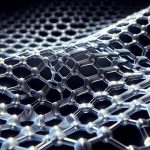Imagine wearing clothes that not only look good but also conduct electricity, keep you cool, and protect you from bacteria. Graphene-enhanced fabrics promise just that. You're probably wondering how one material can offer such a wide range of benefits. These fabrics combine cutting-edge technology with sustainable practices, making them a game-changer for the textile industry. But what exactly is graphene, and how does it transform ordinary fabrics into high-tech marvels? Let's explore what makes graphene so special and how it's set to revolutionize what you wear.
Table of Contents
Key Takeaways
- Graphene-enhanced fabrics offer superior comfort, durability, and temperature regulation, making them ideal for everyday wear.
- These fabrics exhibit excellent electrical and thermal conductivity, outperforming traditional materials like copper and silicon.
- Smart textile applications, including wearable technology and interactive fabrics, are revolutionized by graphene's properties.
- Antibacterial and antiviral properties of graphene-enhanced textiles provide significant health benefits, especially in healthcare settings.
- Sustainable production methods and eco-friendly solutions ensure the environmental impact of graphene-enhanced fabrics is minimized.
What Is Graphene?
Graphene is a single layer of carbon atoms arranged in a two-dimensional honeycomb lattice. When you explore the graphene structure, you'll find that its unique configuration grants it exceptional properties. Each carbon atom is bonded to three others, creating a hexagonal pattern that's both robust and flexible. This arrangement isn't just for show; it's the secret behind graphene's extraordinary capabilities.
You must understand that graphene's structure directly impacts its conductivity properties. Electrons can move effortlessly across this lattice, making graphene an excellent conductor of electricity. It outperforms traditional materials like copper and silicon, offering faster electron mobility and minimal resistance. This remarkable conductivity isn't limited to electricity; graphene also conducts heat with incredible efficiency.
Integrating graphene into fabrics can revolutionize the textile industry. Imagine clothing embedded with conductive pathways, enabling smart textiles that can monitor health metrics or even charge your devices.
Properties of Graphene
You'll be amazed by the exceptional properties that make graphene a material like no other. Known for its high conductivity and lightweight durability, graphene stands out in the world of advanced materials. It's a single layer of carbon atoms arranged in a two-dimensional honeycomb lattice, offering a unique combination of characteristics that are highly sought after in various industries, especially textiles.
Graphene's high conductivity allows it to efficiently conduct electricity and heat, making it ideal for electronic textiles. Imagine a fabric that can charge your devices or regulate your body temperature; that's the power of graphene. Additionally, graphene is incredibly strong yet lightweight, providing unparalleled durability without adding bulk to the fabric. This means you get textiles that are not only tough but also comfortable to wear.
Here's a quick overview of graphene's key properties:
| Property | Description | Benefit to Fabrics |
|---|---|---|
| High Conductivity | Excellent electrical and thermal conductivity | Smart textiles, temperature regulation |
| Lightweight | Extremely low density | Comfortable, non-bulky wear |
| Durability | High tensile strength, resistant to wear and tear | Long-lasting, resilient textiles |
| Flexibility | Can be bent and folded without breaking | Adaptable and versatile fabric applications |
These properties make graphene a revolutionary material, driving innovation in the textile industry.
Production of Graphene Fabrics
To produce graphene fabrics, manufacturers integrate graphene into textile fibers through methods like chemical vapor deposition and coating techniques. By doing so, you'll find that the textile industry is embracing this fabric innovation to push the boundaries of material science.
Chemical vapor deposition allows for a uniform and controlled application of graphene onto fibers, ensuring consistency and maximizing the material's unique properties.
In addition, coating techniques enable the application of graphene layers to existing fabrics, providing a more versatile and scalable production approach. These methods aren't just about enhancing the fabric's performance; they also contribute to sustainable manufacturing practices.
Graphene technology allows for the creation of textiles that are more durable and require less frequent replacement, thereby reducing waste. You'll appreciate that this cutting-edge process not only involves high precision but also aligns with the industry's push towards eco-friendly solutions.
As the demand for advanced materials grows, the integration of graphene into textiles signifies a significant leap forward. It's a blend of innovation and sustainability, setting a new standard for the future of fabrics. This is how graphene technology is revolutionizing the textile industry, one fiber at a time.
Benefits for Everyday Wear
Imagine donning clothes that not just look good but also offer unparalleled comfort and durability. Fabrics enhanced with graphene provide precisely that. These textiles are crafted to be both stylish and versatile, making them suitable for a myriad of occasions—from casual outings to more formal events. You'll find that these fabrics adapt seamlessly to your everyday needs, offering a perfect blend of aesthetics and functionality.
The integration of graphene into fabrics results in materials that are not only incredibly strong but also exceptionally lightweight. This balance guarantees that your clothes remain comfortable throughout the day, regardless of the activities you partake in. Furthermore, graphene's thermal properties help regulate your body temperature, keeping you cool in the summer and warm in the winter.
Here's a quick comparison to illustrate the advantages:
| Feature | Conventional Fabrics | Graphene-Enhanced Fabrics |
|---|---|---|
| Comfort and Durability | Moderate | Exceptional |
| Stylish and Versatile | Limited | Highly Adaptable |
| Thermal Regulation | Poor | Excellent |
Smart Textile Applications
Graphene-enhanced fabrics don't just elevate everyday wear; they also pave the way for groundbreaking smart textile applications. Imagine clothing that adapts to your needs, monitors your health, and even interacts with digital devices. With the integration of wearable technology and interactive fabrics, these innovations become reality, pushing the boundaries of what's possible in fashion and functionality.
These advanced textiles are more than just high-tech gadgets; they're crafted from sustainable materials, ensuring they're as eco-friendly as they're cutting-edge. The fusion of graphene with textiles offers unparalleled conductivity and flexibility, making it perfect for creating smart garments that respond to your environment and lifestyle.
Consider the emotional impact of owning such innovative clothing:
- Feel empowered knowing your wardrobe is at the forefront of technological advancement.
- Experience convenience with interactive fabrics that adjust to your body temperature.
- Embrace sustainability by choosing eco-friendly textiles that are better for the planet.
- Stay connected with garments that sync seamlessly with your devices.
- Achieve mastery in your daily life with clothing that enhances performance and well-being.
Impact on Healthcare
You'll be amazed at how graphene-enhanced fabrics can revolutionize healthcare.
These fabrics boast impressive antibacterial and antiviral properties, which can help keep infections at bay.
Plus, they can greatly enhance wound healing, offering a promising solution for patients and medical professionals alike.
Antibacterial and Antiviral Properties
The integration of graphene into fabrics offers significant antibacterial and antiviral benefits, revolutionizing healthcare textiles. Imagine wearing clothes that not only keep you comfortable but also protect you from harmful pathogens. Antibacterial textiles and antiviral clothing are no longer futuristic concepts; they're here, thanks to graphene.
Graphene's unique properties make it a powerful agent against bacteria and viruses. When integrated into fabrics, it creates a hostile environment for these pathogens, reducing their ability to survive and spread. You're not just wearing clothes; you're donning a shield.
Consider the emotional impact of these advancements:
- Safety: Feel secure knowing you're protected from harmful microbes.
- Peace of Mind: Reduce the anxiety of potential infections in high-risk environments.
- Empowerment: Take control of your health with garments that actively fight pathogens.
- Innovation: Be at the forefront of groundbreaking textile technology.
- Sustainability: Enjoy long-lasting protection without frequent disinfecting.
You understand the importance of cutting-edge solutions in healthcare. Graphene-enhanced textiles don't just offer comfort—they provide an essential layer of defense. With these innovations, you're not only embracing the future of fabrics, but you're also prioritizing your health and well-being.
Enhanced Wound Healing
Imagine speeding up your recovery time with fabrics designed to enhance wound healing. Graphene-enhanced textiles offer precisely that, making them a revolutionary addition to healthcare. These advanced fabrics facilitate expedited regeneration of damaged tissues, providing a speedier recovery process.
By incorporating graphene, these textiles promote cell growth and repair, ensuring that wounds heal faster and more effectively.
Not only do these fabrics aid in quicker healing, but they also provide heightened comfort. The lightweight and flexible nature of graphene-enhanced fabrics means you can wear them without experiencing irritation or discomfort. This is particularly beneficial for patients who need to wear wound dressings for extended periods.
The therapeutic benefits don't stop there. Graphene's excellent thermal and electrical conductivity can deliver targeted heat therapy, further aiding in the healing process. Additionally, these textiles offer enhanced breathability, ensuring that the wound area remains dry and healthy, reducing the risk of infection and promoting ideal healing conditions.
Environmental Considerations
When evaluating graphene-enhanced fabrics, it's important to take into account their environmental impact. As someone who values mastery in textile innovations, you should scrutinize both the sustainability concerns and eco-friendly alternatives.
Graphene's potential to revolutionize fabrics also brings about questions on its ecological footprint. Are we trading one problem for another, or can graphene fabrics genuinely lead to greener solutions?
Consider these critical environmental factors:
- Sustainability concerns: How sustainable is the production and disposal of graphene-enhanced fabrics?
- Eco-friendly alternatives: Are there other materials that offer similar benefits without compromising the environment?
- Recycling possibilities: Can these fabrics be effectively recycled, thereby reducing waste?
- Green manufacturing techniques: Are the methods used to produce graphene fabrics aligned with green manufacturing principles?
- Long-term environmental impact: What're the potential long-term effects of widespread use of graphene-enhanced textiles?
Frequently Asked Questions
How Does Graphene Affect the Durability of Fabrics?
Graphene's impact on fabrics greatly enhances durability. You'll notice improved fabric strength, leading to increased textile longevity. This durability enhancement means your textiles last longer and withstand wear and tear better than traditional materials.
Are Graphene-Enhanced Fabrics Safe for Individuals With Sensitive Skin?
Imagine wrapping yourself in a second skin. Graphene-enhanced fabrics are designed to minimize skin irritation and allergy concerns while optimizing breathability and comfort levels. You can trust their innovative design for sensitive skin.
Can Graphene-Enhanced Fabrics Be Dyed or Printed On?
You can definitely explore dyeing capabilities and printing options with graphene-enhanced fabrics. They support vibrant designs while maintaining environmental impact and sustainability efforts, ensuring your creations are both eye-catching and eco-friendly.
What Is the Cost Comparison Between Graphene Fabrics and Traditional Textiles?
Imagine a luxury car versus a bicycle. You'll find graphene fabrics are pricier due to advanced production processes. However, they promise superior durability and cost efficiency in the long run, unlike traditional textiles.
How Do Graphene Fabrics Perform in Extreme Weather Conditions?
You'll find graphene fabrics excel in extreme weather. They offer superior heat resistance and moisture-wicking properties, ensuring you stay dry. Their insulation and breathability balance keeps you comfortable, whether in scorching heat or freezing cold.
- Is Corduroy Stretchy? Exploring the Fabric’s Flexibility and Uses - July 5, 2025
- How to Wash Empyre Corduroy Pants for Best Care and Longevity - July 5, 2025
- Hem Corduroy Pants by Hand: A Step-by-Step Guide - July 5, 2025







